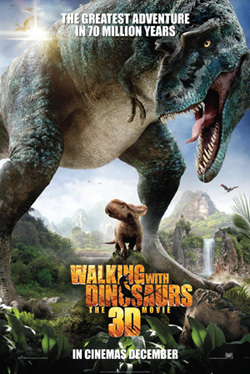Everybody loves dinosaurs. Recent proof of this has been a story on pictures of plastic dinos gone wild that went viral. As kids, we boys have our trucks and cars, our action figures (strictly Star Wars for me), and our dinosaurs. However, dinosaurs aren't just for boys. The first word longer than one syllable that my niece uttered was "paleontologist." That was her career of choice until Hannah Montana hit the scene.
But I digress. Back to dino-business. Walking With Dinosaurs is a new movie hitting the theaters this weekend, and although it is a kid's movie, it is also chock full of science. The filmmakers have gone to great lengths to make sure the portrayal of the dinosaurs and their environments are as accurate as possible, except the part about the dinosaurs talking. They really wanted moviegoers to get an accurate experience of how it might have felt to walk with dinosaurs.
I was able to speak with David Krentz, the character designer for the movie, and Dr. Stephen Brusatte, one of several paleontologists who served as consultants for the movie.
Krentz: Because they are real-life monsters. They exist in this space between fantasy and reality. They really did exist. We have evidence of it. They are gigantic. They are mysterious. We will never know exactly what they looked like, and so there is plenty of room for imagination. There is plenty of room to study them as well. It is just a really interesting mix between what is real and what is fantasy. It really appeals to kids, and I think that is important because I have always said that dinosaurs are the gateway drug to science for kids.
R: When you design the dinosaurs, do you have to deal with differing opinions among paleontologist consultants, and if so, how do you handle that?
K: Well at first, my mandate was to create the most accurate dinosaurs based upon all scientific evidence. The Pachyrhinosaurus species that was chosen really hadn't been described yet. They were really still cleaning the bones. They were trying to figure it out as we were figuring out, which was pretty cool. But, I had to answer to five paleontologists when I was doing the digital models and the drawings, and to get five paleontologists to agree on anything is not an easy task. I did manage to get a consensus and I think a consensus was the important thing.
R: Some of the species that were chosen for the movie are not the most common. Was there a purpose behind that?
K: The idea was to keep it in one place at one time, which is what almost all dinosaur movies never get right. They mix everybody's favorites, whereas those species are spread amongst millions of years, and entire continents. This was to recreate a particular place with those particular species. Pipestone Creek was the name of the formation where all the bones were found. It was choosing all of the animals that could have been there at that place at that time to really get the complete ecosystem down.
R: You have worked on dinosaur movies for many years. Do your designs have to change as the knowledge of the physiology of some of these species changes?
K: Oh yeah, I directed a dinosaur movie a few years ago, and also made a majority of the models for that one as well. That was only five years ago, and there is a lot of them that are now obsolete, you know, within five years. I think in Walking With Dinosaurs probably the biggest contention is whether or not our Tyrannosaur [Gorgosaurus] would have had feathers or not.
The reason for not putting feathers was simply there hadn't been an animal that large found with feathers. And then of course, when we are done, out comes the fossil of a new Tyrannus which was 30 feet long, which is larger than a Gorgosaurus. It was entirely covered in thick feathers and fur, and it was a Tyrannosaur. So it was like, "Whoops." Our only saving grace is that they seem to have found skin impressions from northern Tyrannosaurs that looked like they only had pebbly skin. An ostrich also has part feathers part skin, so who knows. Only time will tell. We could be proven completely right or completely wrong.
R: Stephen, from your point of view as a paleontologist, what is unique about this project?
Brusatte: It was really something to see the final version on the big screen with your 3D glasses and to see these dinosaurs just pop out of the screen at you. It's hard to put that into words. I think that it is a movie, it is entertainment, it is not a science documentary, but I think it is probably the most realistic portrayal of dinosaurs that has ever been done, not just in the movies, but really anywhere.
There were a lot of paleontologists that were consultants, so you know the dinosaurs are good. They are pretty accurate, their environments are accurate, and that is a pretty unique opportunity for those of us in the scientific community to be able to have our science portrayed in a blockbuster movie, and for the movie to do a pretty good job with it. As somebody who studies these things, when I watch the film, it was like how I imagine watching these animals when they were alive.
R: How exact of a science is this? When you consult on the behavior of these animals, do you think you are pretty close, or is this your best guess?
B: We know bits and pieces. I think we know with pretty good confidence the broad brush strokes of it, or the scaffolding of it. The movie is storytelling, and really the rest of anything we do with dinosaurs, museum exhibits, books, or TV shows, or whatever, is always going to have quite a lot of speculation, but what is good with this film is that the speculation is pretty scientifically grounded.
R: Why do you think kids are so fascinated with Dinosaurs?
B: That's the big money question. Thankfully they are because it keeps people like me employed. It's something that we think about a lot, because there is this almost primal fascination with dinosaurs. We see it all of the time when we go into classrooms and we talk to kids. I think more than anything dinosaurs were just fantastic creatures. Some of these things, like the T-Rex, there is just nothing alive today like a T-Rex. You know, a five ton, 40 foot long predator roaming around the land, and there is nothing like the big, long-necked Sauropod dinosaurs. There is just nothing to compare them to and I think they are more fantastic than most things that humans have created in legends and myths; unicorns, and leprechauns, and dragons, you know whatever these things are. Dinosaurs are more fascinating than anything humans have created and they were real.
For a longer version of this interview (to be posted in the near future, after the holidays) visit alejandrotrojas.com.

